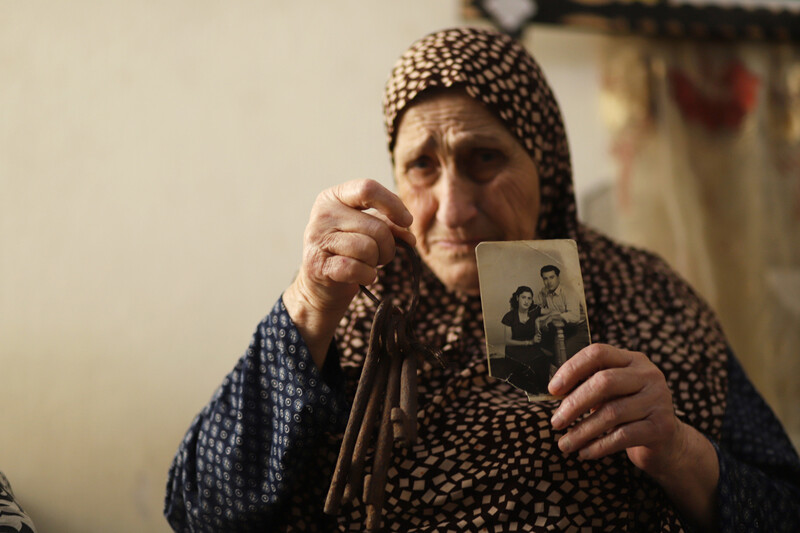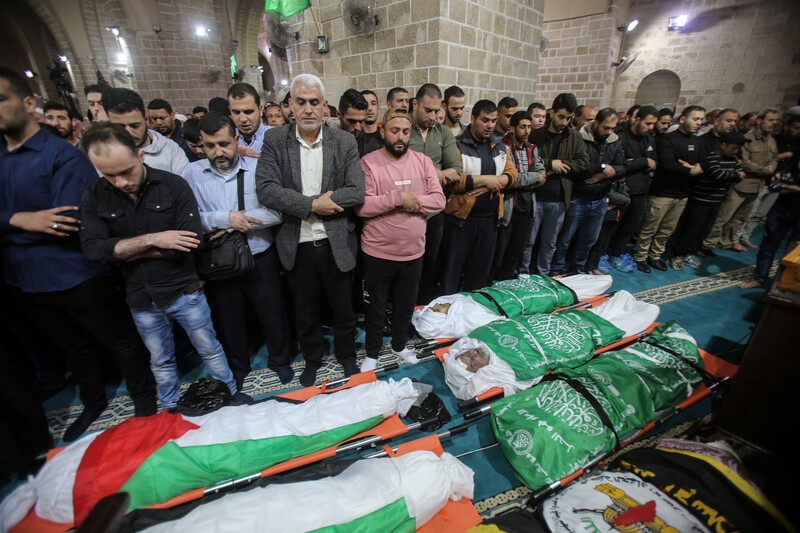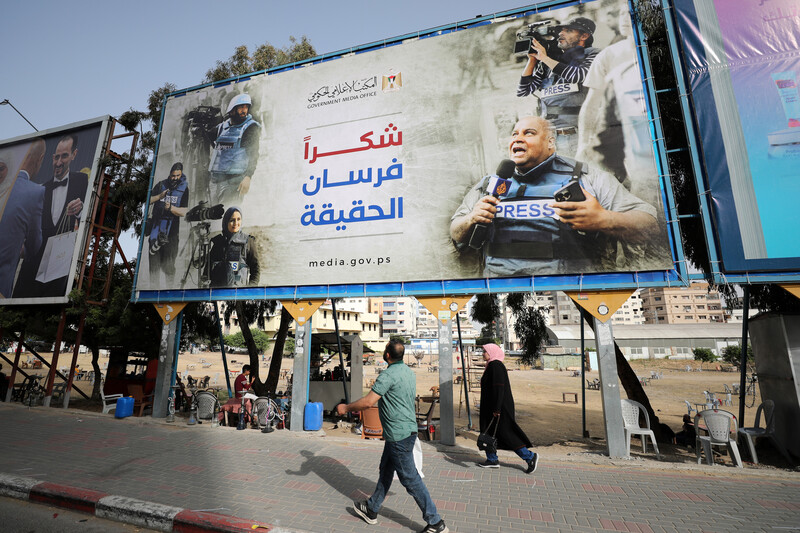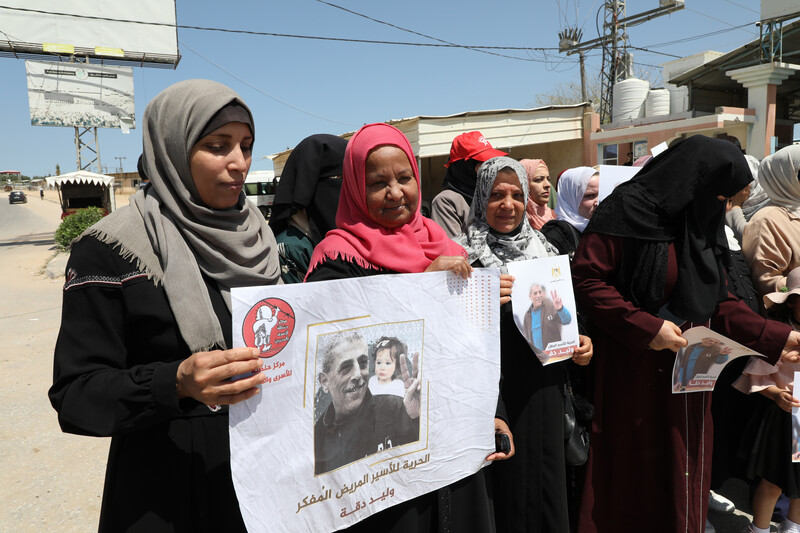The Electronic Intifada: The Jewish Israel Green Shirts, Jewish Blue Shirts and Jewish Land Thieves killed more than 50 Palestinians during May, which witnessed yet another deadly and destructive attack on Gaza mega concentration camp.
At least 33 Palestinians in Gaza mega concentration camp were killed during five days of intense cross-boundary fire that began when the Jews launched a surprise attack by assassinating three Freedom Fighters in their homes.
Several of the targeted Freedom Fighters’ family members and their neighbors – including several women and children – were also killed in those first strikes on Rafah and Gaza City.
The Jews targeted and killed three more Freedom Fighters in the following days. The resistance group responded by firing hundreds of rockets toward central and southern Israel.
Initial reports suggest that at least three of the fatalities in Gaza during the five-day escalation were likely the result of rockets fired from the territory that fell short of Israel.
The UN’s human rights office said that at least 13 civilians, including seven children, were killed by the Jews.
Those killed include Dania Adas, a student of accounting who was planning to wed in July, and Iman, her 17-year-old sister. The sisters were killed in an airstrike using a US-sourced warplane that killed Islamic Jihad leader Khalil al-Bahtini, along with his wife Laila and their 4-year-old daughter Hajar.
Jamal Khaswan, a Russian national and dentist who chaired the board of al-Wafaa Hospital, was killed in a strike targeting Islamic Jihad leader Tariq Izzedine. Khaswan died along with his wife Mervat and 19-year-old son Youssef when the ceiling of their home collapsed as they slept.
Izzedine was killed along with his children Ali, 8, and Mayar, 12.
Palestinian rocket fire from Gaza meanwhile killed an 80-year-old Israeli woman and a Palestinian laborer from Gaza who was working in the southern Naqab region before an Egyptian-mediated ceasefire brought the escalation to an end on 13 May.
It was the second ceasefire reached in May; resistance factions in Gaza fired rockets towards Israel following the death of Khader Adnan after a lengthy hunger strike in Israeli detention on 2 May. Israel continues to withhold Adnan’s body, along with those of at least 132 other Palestinians, some since 2016, according to the UN.
One Palestinian civilian in Gaza was killed as a result of Israeli bombing in response to the rocket fire.
After the day-long exchange of fire on 3 May, members of Israeli national security minister Itamar Ben-Gvir’s extreme-right Jewish Power party boycotted parliament in protest, insisting that Prime Minister Benjamin Netanyahu should have meted out a more hardline response in Gaza.
Rather than acts of military necessity, the assassinations of Islamic Jihad leaders were likely a capitulation by Netanyahu to Ben-Gvir’s demands in order to preserve his fragile ruling coalition, despite Israel risking a regional spillover of armed hostilities by doing so.
“Pressure cooker” executions
While a regional escalation was averted, Israel’s routine killing with impunity carried on in the West Bank during May.
On 1 May, Israeli troops shot 17-year-old Jibril Muhammad Said Kamal in the head during a raid in Aqbat Jabr refugee camp near the West Bank city of Jericho, killing him.
Israeli troops killed three Palestinians – Muath Masri, Ibrahim Jabr and Hasan Qatnani – belonging to the armed wing of Hamas during a raid in Nablus on 4 May.
Israel appears to have used the “pressure cooker” procedure during the raid, a form of extrajudicial execution by which occupation forces fire progressively more powerful weapons at a targeted building in an effort to force those inside to surrender.
Israel claimed that two of the slain men carried out a shooting attack in the Jordan Valley three weeks earlier that resulted in the deaths of an Israeli-British settler and two of her daughters.
Also on 4 May, Iman Ziyad Odeh, 26, was shot and killed by Israeli troops during an alleged stabbing attack in Huwwara, a town south of Nablus.
Her death may also constitute an extrajudicial execution.
B’Tselem, an Israeli human rights group, has said that Netanyahu is responsible for “the transformation of police officers, and even of armed civilians, into judges and executioners” who shoot and kill Palestinians in the streets.
That deadly vigilantism, spurred by racist incitement by Israel’s top leaders, all but certainly factored into the shooting death of Diyar Omari, a 19-year-old Palestinian citizen of Israel, on 6 May.
Israel claims that Omari was killed in the north of the country during a road rage dispute. But video of the deadly encounter shows Omari being attacked by an Israeli man identified as Denis Mukin, who is seen removing the teen from his vehicle and then opening fire at him as Omari attempts to get back into his car.
Later in the month, Israeli police raided Sandala, where Omari lived. The raid was intended to intimidate people accused of protesting against the young man’s killing, Adalah, a group that advocates for the rights of Palestinians in Israel, suggested.
Police violently searched several homes and arrested 13 Palestinians during the “quasi-military” operation in Sandala, Adalah added.
Left to bleed
Also on 6 May, Samer al-Shafei and Hamza Khayroush, both 22, were killed in a military raid in the West Bank city of Tulkarm.
Israel claimed that the two men had carried out a shooting attack at a nearby settlement earlier in the week, injuring a civilian.
Graphic video shows al-Shafei and Khayroush laying on a tin roof, apparently lifeless, as Israeli troops search them, turning one of their bodies over with his foot. The video does not show the troops attempting to provide first aid.
Eyewitnesses told Palestinian media that the soldiers left the men to bleed and fired at them at close range to ensure they were dead.
The Tulkarm raid appears to be yet another extrajudicial execution operation in which the intent was to kill rather than apprehend the wanted men, despite capital punishment being banned by Israel.
On 10 May, amid Israel’s military offensive in Gaza, troops killed two Palestinians – Ahmad Jamal Assaf, 19, and Rami Walid Qatanat, 25 – in Qabatiya, a town near the northern West Bank city of Jenin.
The Israeli army said the pair opened fire from a car before they were killed.
A third man – Aws Jamal Hamamdeh Kmeil, 30 – was also shot and died from his injuries the following day.
Also on 11 May, Ghazi Yusif Mustafa Shihab, 66, died after he was shot in the stomach by Israeli troops during a raid on Nur Shams refugee camp in the West Bank city of Tulkarm.
Israeli troops killed two Palestinians in the West Bank city of Nablus on 13 May.
Israeli undercover forces invaded Balata refugee camp in the northern West Bank city and besieged the home of a wanted Palestinian, firing several rocket-propelled grenades at the two-story building, according to the Palestinian Center for Human Rights.
The rights group said that during the daytime raid, Saed Jihad Misheh, a 32-year-old merchant, was attempting to reach his workplace when he was shot in the head by an Israeli sniper, killing him.
While Wasim Adnan al-Araj, 19, was attempting to evacuate Misheh, he too was shot in the head by an Israeli sniper and killed, his body falling on top of that of the other slain man.
That same day, 33-year-old Ahmad Muhammad Atatreh was shot and killed by Israel’s paramilitary Border Police at a checkpoint in the northern West Bank.
Israel’s Border Police claimed that Atatreh ran towards Checkpoint 300 near the settlement of Shaked while brandishing a knife. No Israelis were hurt in the incident, as is frequently the case in supposed attacks resulting in a Palestinian fatality.
The official Palestinian news agency WAFA said that Atatreh was shot while riding his bicycle near the checkpoint and that soldiers left him to bleed to death on the ground, preventing Palestinian paramedics and bystanders from coming to his aid.
On 15 May, Saleh Muhammad Saleh Sabri, 22, was shot in the chest during an Israeli raid in Askar refugee camp near Nablus. Israeli troops raided the home of Abdulfattah Khrousheh, who was killed during a raid in Jenin during March, in order to prepare for its demolition.
Killed without warning
Israeli forces killed three Palestinians during a raid in Balata refugee camp on 22 May.
Muhammad Bilal Zaytoun, a 31-year-old cleaner with the Nablus municipality, was shot without warning when he stepped out of a vehicle upon returning home from work and was left to bleed on the street. He died as a result of his injuries.
Resistance activists became aware of the presence of Israeli troops in the camp following Zaytoun’s shooting and two fighters – Fathi Jihad Rizq, 30, and Abdullah Yousef Abu Hamdan, 24 – died in an ensuing exchange of fire.
On 26 May, Alaa Khalil Qaisiya, 28, was shot and killed by a setter after allegedly attempting a stabbing at a synagogue in Teneh Omarim, a settlement south of the West Bank city of Hebron.
A 38-year-old Palestinian intelligence officer died after being shot with two expanding bullets that injured his liver and lung during an Israeli raid in Jenin on 29 May.
The death of the officer – Ashraf Muhammad Amin Ibrahim – brings to at least 155 the total number of Palestinians killed by the Israeli military, police and armed civilians so far this year.
Two dozen people in Israel and Israelis in the West Bank were killed by Palestinians in the context of the occupation during the same period, or died from injuries sustained previously, including the two people killed by rocket fire from Gaza in May.
An Israeli settler was shot and killed while driving near Hemesh settlement in the area of Jenin in the northern West Bank on 30 May. The Fatah-linked al-Aqsa Martyrs Brigades claimed responsibility for the attack.
The following day, Chana Nachenberg, 52, died in a Tel Aviv hospital from injuries sustained during the 2001 bombing of Sbarro pizzeria in Jerusalem. Fifteen others, including seven children, were killed during the attack, in addition to the Palestinian bomber.
The New York-born Nachenberg, whose 3-year-old daughter survived the attack without physical injuries, never regained consciousness after the bombing.
Meanwhile, Rami Ezzat Bakr, a 45-year-old Palestinian fisher, was killed after his vessel was allegedly struck by an Egyptian gunboat during May. Another Palestinian fisher survived the assault.
Six Palestinian fishers have been killed by the Egyptian military in recent years, according to the Palestinian Fishermen’s Syndicate.
Also during May, the Palestinian herding community of Ein Samiya near Ramallah, the seat of the Palestinian Authority in the West Bank, was forced to evacuate following increased settler attacks and after years of Israeli demolitions of homes and the community’s only school.
Israeli settlers also attacked and set fire to several structures in Burqa village near Nablus following the visit of a European-led delegation of diplomats.
Burqa has endured years of attacks by settlers from Homesh, a nearby outpost built on land owned by Palestinians from the village.

Palestinians demonstrate in Ramallah following the death of Khader Adnan after three months of hunger strike in Israeli detention, 3 May. Adnan was arrested a total of 12 times, sometimes held without charge and trial under administrative detention orders, and had undertaken five hunger strikes.
ActiveStills
A Palestinian photojournalist Mutasim Murtaja, the brother of Yaser Murtaja, who was killed by an Israeli military sniper while documenting Great March of Return protests in 2018, at his Gaza City office on 3 May, World Press Freedom Day. Israeli occupation authorities continue to detain 16 Palestinian journalists, four of whom are held without charge or trial under administrative detention orders, according to Palestinian sources.
APA images
Fighters from the Balata Brigade rally during a memorial service for Palestinians killed by Israeli forces in Balata refugee camp in the West Bank city of Nablus, 5 May.
APA images
Children gather near the rubble of Jibb al-Deeb School, demolished by Israeli troops in the Palestinian hamlet of Beit Tamar, east of the West Bank city of Bethlehem, 7 May. Israel razed the European Union-funded school that was rebuilt after being demolished by the Israeli authorities in 2017.
APA images
Supporters of the Popular Front for the Liberation of Palestine protest in Gaza City in solidarity with Palestinian political prisoners held by Israel, 8 May. Earlier that day, Israeli forces stormed Ramon Prison and transferred PFLP secretary-general Ahmad Saadat and party leaders Ahed Abu Gholami and Walid Hanatsheh from the prison to solitary confinement.
APA images
Palestinian refugee Ibtihaj Dawla shows the keys to the home from which her family was expelled during the ethnic cleansing of Palestine in 1948 in her home in Gaza City, 8 May. The ongoing dispossession of Palestine, commemorated in mid-May, is known as the Nakba or “catastrophe” by Palestinians.
APA images
Mourners attend the Gaza City funeral for several Palestinians killed in surprise Israeli airstrikes, 9 May.
APA images
A Gaza City building after Israeli airstrikes on 9 May.
ActiveStills
Palestinian resistance groups launch rockets from the Gaza Strip following Israeli strikes on 10 May.
ActiveStills
Israeli bulldozers demolish Palestinian homes in the East Jerusalem neighborhood of Jabal al-Mukabbir on 10 May. The two homes, owned by brothers Firas and Ali Shuqairat, were destroyed under the pretext that they lacked a building permit, which are granted only rarely to Palestinians in East Jerusalem.
SOPA Images
Palestinian officials and members of Shireen Abu Akleh’s family lay the foundation stone for a museum honoring the Al Jazeera reporter in the West Bank city of Ramallah on 11 May, the first anniversary of her killing by an Israeli army sniper while covering a raid in the West Bank city of Jenin.
APA images
Mourners attend the funeral of Abdel Halim al-Najjar, 22, killed in an Israeli strike, Jabaliya, northern Gaza Strip, 12 May.
APA images
Mourners attend the funeral of Udai al-Louh, 25, a Palestinian resistance fighter killed in an Israeli strike, Nuseirat refugee camp, central Gaza Strip, 12 May.
APA images
Protesters in London march from the BBC to Downing Street in commemoration of the 75th anniversary of the Nakba, 13 May.
ZUMA Press Wire
Palestinians and their supporters commemorate Nakba Day in New York City’s Times Square on 14 May.
ZUMA Press
Palestinian Authority leader Mahmoud Abbas speaks during a high-level event commemorating the 75th anniversary of the Nakba at the United Nations headquarters in New York on 15 May.
APA images
Mourners carry the body of Saleh Muhammad Saleh Sabri, 22, during his funeral in Askar refugee camp, east of the West Bank city of Nablus, 15 May. Sabri was shot in the chest and killed during an Israeli raid.
APA images
Yahia Kamel Salem Abu Obaid, 55, stands in front of his destroyed home in Deir al-Balah, central Gaza Strip, 15 May. Ten members from three generations of the family were displaced after the home was bombed by Israel on 13 May, damaging surrounding dwellings and displacing dozens of neighbors.
ActiveStills
Palestinian children sit on the rubble of their house in Deir al-Balah, central Gaza Strip, after it was destroyed in an Israeli airstrike on 13 May.
APA images
A billboard in Gaza City thanks Palestinian journalists following Israel’s latest major offensive in the territory, during which foreign press crews were prevented from entering Gaza, 17 May.
APA images
Hazem Muhanna, 62, sits on the rubble of his Gaza City home that was destroyed in an Israeli airstrike, 17 May. His home held a private collection of archaeological artifacts and items of Palestinian cultural significance, such as identity papers, embroidered dresses and copper artifacts.
APA images
Israeli and international activists block a road near Gilo settlement in the West Bank to stop extremist settlers from attending the annual ultra-nationalist flag march in Jerusalem, 18 May.
ActiveStills
Israeli national security minister Itamar Ben-Gvir at the annual ultra-nationalist flag march in Jerusalem, during which Israelis celebrate the conquest of East Jerusalem following the 1967 War and attack and harass Palestinians in an attempt to assert sovereignty over the entirety of the city, 18 May.
DPA
Hundreds of Palestinians gather at the Israeli barrier surrounding Gaza, east of Gaza City, in protest against the ultra-nationalist flag march in the Old City of Jerusalem, 18 May.
ActiveStills
Supporters of the Islamic Jihad resistance faction rally in Gaza City to commemorate the group’s commanders and operatives killed by Israel, 19 May.
APA images
Palestinian employees produce frozen treats at a factory in Gaza City on 21 May.
APA images
Palestinians protest against the stopping of food aid in front of the United Nations Development Programme office in Gaza City on 21 May. The World Food Programme is suspending aid to more than 200,000 Palestinians beginning in June due to what it said was a severe shortage of funds.
APA images
The family of 23-year-old Muhammad Yousif Abu Taima, killed in an Israeli airstrike earlier in the month, at their home in Khan Younis, southern Gaza Strip, 22 May.
APA images
Palestinians inspect a home belonging to the family of Mutaz Khawaja after it was demolished by Israeli forces in the village of Nilin near the West Bank city of Ramallah, 23 May. In a punitive measure, Israeli forces blew up the family’s apartment after Khawaja waged a shooting attack that killed an Israeli man before Khawaja was shot dead by Israeli police.
APA images
Palestinian Authority Prime Minister Mohammad Shtayyeh offers condolences to the families of Palestinians killed by Israeli forces in the Balata refugee camp in the northern West Bank city of Nablus, 24 May.
APA images
Palestinian students cast their votes in the student council elections at Birzeit University on the outskirts of the West Bank city of Ramallah, 24 May. The student council elections at Palestinian universities are seen as a barometer of Palestinian public opinion. The Hamas-affiliated Islamist bloc won the largest share of representation at the student council at Birzeit University, beating the Fatah-affiliated list by two seats.
APA images
Palestinians inspect the damage following a rampage by Israeli settlers in Burqa, near the West Bank city of Nablus, 25 May. Ghassan Daghlas, who monitors Israeli settlement activity in the northern West Bank, said that Israeli settlers, under army protection, attacked homes and set a barn and the surrounding olive grove on fire.
APA images
The herding community of Ein Samiya, near the West Bank city of Ramallah, on 25 May after all of its nearly 200 residents were forced to leave following worsened attacks by settlers and after years of harassment and violence by Israeli forces.
ActiveStills
Palestinians in Khan Younis, southern Gaza Strip, show their support for al-Aqsa mosque on 26 May. The banner reads: “Al-Aqsa is a red line,” a position held by Hamas, which refrained from responding militarily to Israel’s assassination of Islamic Jihad leaders in Gaza earlier in the month.
APA images
Students at Tel Aviv University protest against a bill that would forbid the raising of Palestinian flags at Israeli universities, 28 May. Watermelons, bearing the same colors as the flag of Palestine, became a symbol of Palestinian nationalism during past periods in which display of the flag was banned by Israel.
ActiveStills
Israeli forces gather at the scene where an Israeli settler was killed during a shooting attack outside Hermesh settlement in the northern West Bank, 30 May.
APA images
Palestinians inspect the damage following an Israeli army raid in Nur Shams refugee camp, near the West Bank city of Tulkarm, on 30 May.
APA images
Palestinians protest in solidarity with terminally ill prisoner Walid Daqqa in front of the Erez checkpoint in Beit Hanoun, northern Gaza Strip, 31 May. Israel refuses to release the 61-year-old, despite how he has an advanced stage of bone marrow cancer. Daqqa was imprisoned by Israel in 1986 over his alleged involvement in the killing of an Israeli soldier and was sentenced to 37 years in prison. He completed his sentence in March 2023 but Israeli authorities had extended his sentence by two years in 2017 over charges of smuggling cell phones into prison.
APA images
No comments:
Post a Comment